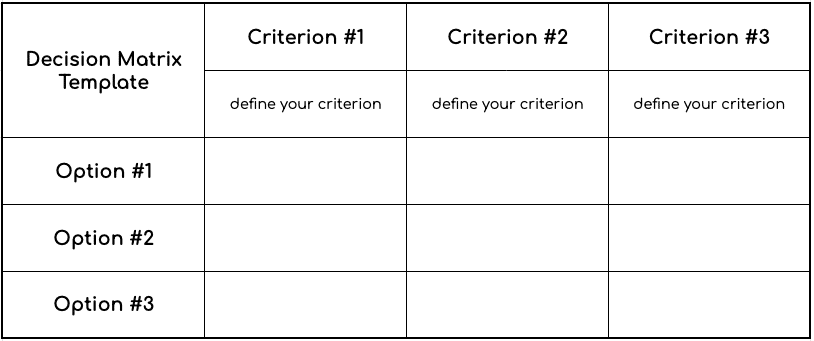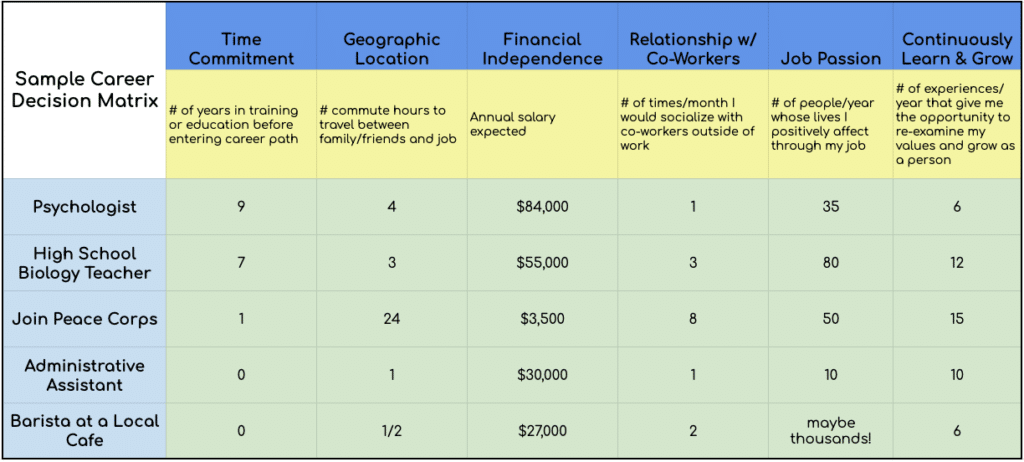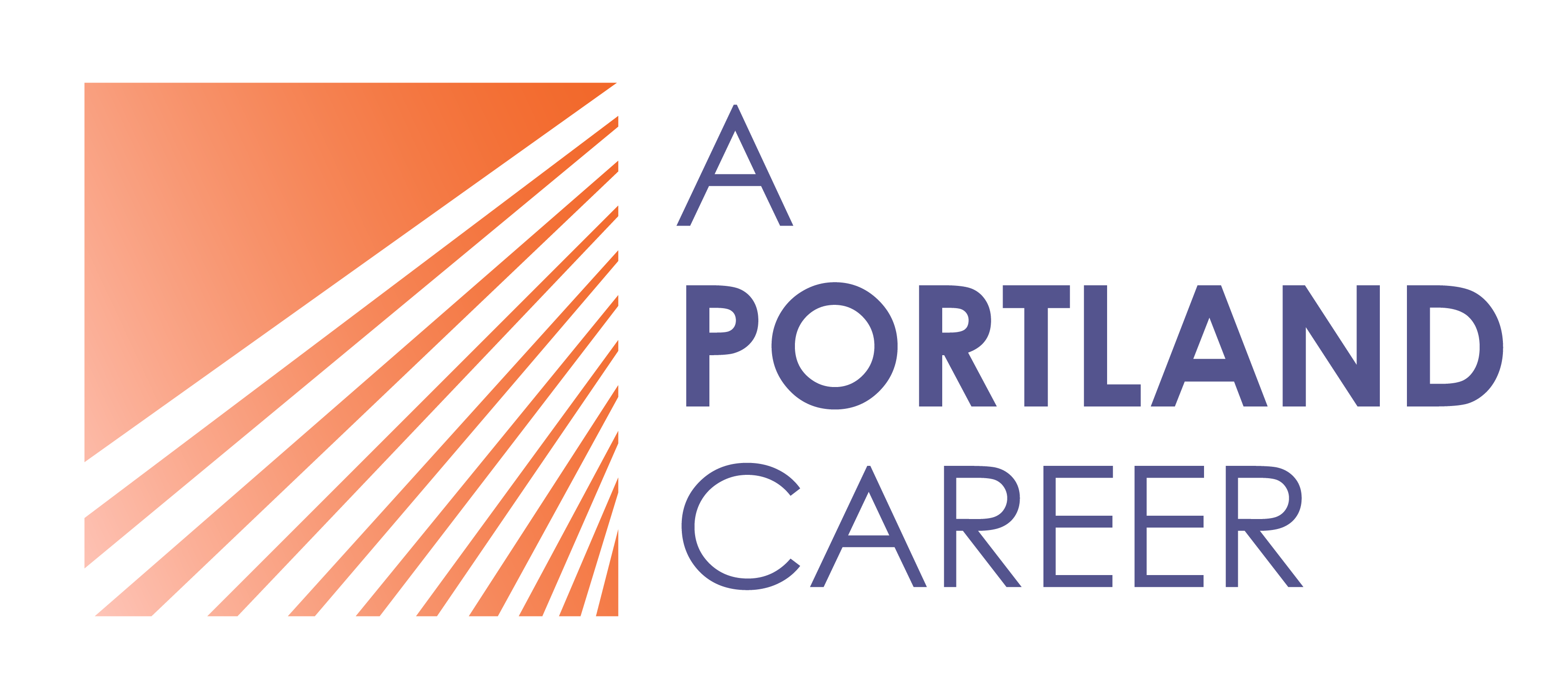In this career exploration brainstorm, we encourage you to think expansively about possible career paths, and then create the ideal career short list for you!
A career decision matrix is a tool that can help you organize your thoughts to make even the most complicated career decisions.
Using a Career Decision Matrix to Overcome Information Overload
By Ursina Teuscher, Ph.D., Suzie Sherman, and Dan Hahn, M.S.
Career search got you overwhelmed? We’re here to give you some guidance

Career decisions often require us to juggle so much information that we can’t think straight. You could take so many different directions, and each has so important consequences: barriers to entry like education, potential salary, whether you’d be willing to move for a job. There’s also uncertainty about how much you may enjoy the work or feel successful doing it. Here’s a practical strategy to organize complicated career exploration decisions.
Career decisions can be complex and overwhelming. In this post, we help you recognize the signs of emotional or information overload and better understand the limits of working memory capacity. We also empower you with external memory aids to help organize your thoughts. You’ll soon see how powerful the simple decision matrix can be toward organizing your thinking about both career options and career criteria, or values. If you want more guidance making career choices, set up an exploratory call with us.
Home → Helpful Articles → Career Exploration → Using a Career Decision Matrix to Overcome Information Overload
Here are a few more articles on making career decisions that should be helpful:
- Your Career Exploration Brainstorm: Deepen your Search!
- 6 Factors that Impact Your Career Change Time Frame
- 7 Expert-Backed Research Tips to Find the Right Career
- The 6 Best Career Exploration Websites to Narrow Down your Job Search
- Getting Clear on Your Career Path: Discerning Your Interests and Passions
If you want more guidance with your career decision making, get in touch with us, and we’ll work together to make a plan.
On This Page

Information overload and working memory capacity
One of the problems in feeling overwhelmed is that we tend to oversimplify things to keep them manageable. We push away decisions, procrastinate, linger in ambivalence, and avoid taking in new information. Sometimes the cause of the overwhelm is because the information is wrapped up in emotions. Making decisions about something important like “What should my career path be?” or “What job offer should I accept?” or “Am I willing to move to a different state for this new job?” can be very charged things to think about.
We also have a built-in cognitive limit to our working memory capacity. Our working memory (as opposed to our long-term memory) determines the number of “items” (thoughts, feelings, concepts, objects) we can focus on at any given time. Whether it’s emotional overwhelm, or cognitive (or a combination!) here are some of the telltale signs you’re having trouble making important decisions:
- You put the decision off for later, even though it is important to you. When confronted with too many options, you get paralyzed and procrastinate on the decision.
- You vacillate between options. You lean toward one choice on some days, and the next day, another. Maybe you even change your mind many times over the course of a day. This might be because there is too much to consider at once, so you limit your attention to specific concerns at different times.
- You disregard or even avoid new information. If you react to new information with confusion and fatigue, rather than interest, it’s probably because your mind is already overloaded.
There’s a relationship between emotional regulation and working memory. But it’s clear that these decision-avoiding tactics in the face of overload keep us from making progress on the task at hand.
One thing at a time: Our limited working memory capacity is one of the reasons “multitasking,” the holy grail of workplace culture, is kinda B.S.

Using external memory aids to increase working memory
We can expand our thinking capacity dramatically if we offload information to external memory aids. Examples of external memory are everywhere:
- Sticky notes on a desk
- Napkin drawings
- Journal writing
- Sketches on a whiteboard
- Computer charts
- Google docs or spreadsheets
- To-Do lists
- Mobile phone reminders
…and more. All these help us think more efficiently by getting information out of our own heads and onto the proverbial page.
These tools also allow us to visualize the tasks or ideas we need to think about. Some of them allow us to further organize the information, for example, they allow us to “chunk” or group information for easier mental processing. Color-coded stickies, different colored pens on a white board, or the columns and rows in a spreadsheet are good chunking tools for grouping information, so all the options make more sense than when they’re just rattling around in our brains.
How to use a decision matrix for career path decisions
Certain forms of external memory are particularly useful for making career decisions. Here’s one example: the decision matrix, (a fancy math term for a table or chart). It’s one of our favorite methods for helping our clients think about career decisions. It accomplishes all the functions for improving our thinking we talked about above: it’s a way to:
- Offload information from our addled brains
- Visually represent the information
- Chunk information into groups for easier mental processing

Here’s a template for a matrix with two axes: options and criteria. We’ll explain how to use it to organize all your thoughts and information on the career decision you may be facing now. Important note: you can add as many rows and columns as you need to incorporate more options or criteria for your decision making.
Create your decision matrix
- Column headers (across the top): fill in your criteria—that is, all the factors or values that matter for your career decision. Criterion 1 could be “geographic location,” criterion 2, “financial independence,” and so on. Think about all the factors you want to weigh in your decision and list them across the top of your table.
- Column header definitions (across the second row): define how you will measure your criteria. For example, for your geographic location, you might want to indicate the hours of commute time from where you live for each of your job options.
- Row headers (down the left side): fill in all your options—for career decisions, these could be general career directions you want to consider if you’re still in the brainstorm phase, or specific job titles that you’ve narrowed your search down to.
- Then fill the cells inside the matrix with your “data”: what do you expect from each of your options, for each of your criteria? That intersection is your data. We flesh this out in the example matrix below (the data is the green section).

Our sample career decision matrix shows career criteria, or values, across the top (in dark blue), how you’re defining the criteria across the second row (in yellow), and possible career options down the left side (in light blue). The data to compare how each career option fulfills your criteria is in green.
Why is the decision matrix such a great tool for career decisions?
- The matrix structure allows as many options and criteria as you want. That way, it can hold a lot of information without overwhelming your thinking. This creates a great amount of clarity.
- It helps you search for information, because each empty cell clearly shows a gap in your knowledge. Some of those empty cells will be easy to fill with a google search, or in an informational interview with someone who works in one of the careers you’re thinking about. Other cells might remain empty, but those are helpful too, because they highlight your true uncertainties.
- It helps you think creatively about how to improve or combine your options to fulfill your criteria even better.
- If you want to involve others in your decision, a table is a great basis for discussion and for sharing your thoughts, notes, concerns, and questions with them.
- The table allows for weighting your criteria and ranking your options, if you want to evaluate your options quantitatively. When you work through your career exploration process with one of our coaches, we can help you get out of your own head, describe important criteria, weigh them against each other, search for options, evaluate them, and then collaboratively craft a well researched career plan.
Final thoughts on using a decision matrix to overcome information overload
Sometimes the task in front of us can overload our working memory circuits, or overwhelm our emotional capacity. Offloading information to an external memory aid allows us to work with this reality and make better, more informed decisions. This can help us break down even the most complicated decisions in our lives so we can more deeply understand and weigh our options best.
If you find yourself overwhelmed by a complex career decision, get out a pen and paper, or a napkin, or a spreadsheet (if you’re geeky like us) and draw up a decision matrix. Feel the peace of mind that comes with knowing you’re making the best decision you can, based on your current knowledge. This is empowering, because once you’ve made your decision, it’ll help you fully commit and take action without fear of regrets!
Key takeaways
- Humans have a limit to our working memory capacity, a cognitive condition that makes it hard to mentally process too much information at once.
- Emotional overwhelm can do the same thing, and, in fact there’s a relationship between our working memory and our emotional load.
- Overload can lead to problems making career decisions like avoiding or putting off dealing with the decision.
- Using external memory aids can help us offload and organize the information from our overloaded brains. These can be as simple as writing your thoughts down on a napkin, or drawing on a sticky note.
- We recommend the decision matrix for making complicated career decisions. This is a simple chat that lets you lay out your career criteria, or values, and the options you’re considering, whether it’s a specific job or a general career path.
- Feel free to get in touch with us if you want help organizing your career search and exploring your options.
Related articles you might be interested in:
Crack The Holland Code and Unlock Your Career Aspirations
The Holland Code is arguably the most practical personality typology for job search. Crack the Code, and unlock your best career path matches.
Is It Time for a New Career Path?
A career expert’s reflection on how to start assessing your career options.
Your Career Values Assessment
So often, our careers seem to be at odds with our core values. This career values exercise gives you permission to think outside the cubicle and find work...





